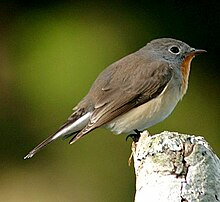Reverse train

The ornithological multiple word Umkehrzug (engl. Reverse migration ) describes a phenomenon of bird migration . The term migration reversal is occasionally used synonymously , but more often it describes small-scale reversal migrations during the bird migration.
Migratory birds migrate in a direction that is a mirror image of the genetically determined migration direction or change the migration direction during the migration, i.e. practically turn around. It appears that this behavior is more prevalent in bird species breeding in the Palearctic and particularly affects migration. The reverse migration is most often found in migrating small birds. The reverse migration as a phenomenon is clearly distinguishable from smaller-scale migration corrections, which all migratory birds show, for example, when wind drifts or cold spells when they return home.
The reasons for the occurrence of the reverse pull have not been fully explored, but meteorological influences and regional magnetic field anomalies are considered to be the most likely causes of this misdirection. Particularly in south-east migrants, such as the miniature flycatcher ( Ficedula parva ) or the carminer ( Carpodacus erythrinus ), reverse migratory movements are mostly associated with strong and sustained winds from the direction of migration. The regular occurrence of the golden-winged warbler ( Phylloscopus proregulus ), which breeds in central Siberia, in western Europe and southern England is due to the phenomenon of the reverse migration.
It is also unclear how large the proportion of birds is that can reorient themselves or those that wander dead due to their wrong direction of migration. Individuals who manage to survive in the wrong winter quarters usually move in the correct direction in the next migration season.
literature
- Peter Berthold : Bird migration. A current overview. Scientific Book Society Darmstadt. 6th edition 2008. pp. 88ff, 125 and 193. ISBN 978-3-534-20267-6 .